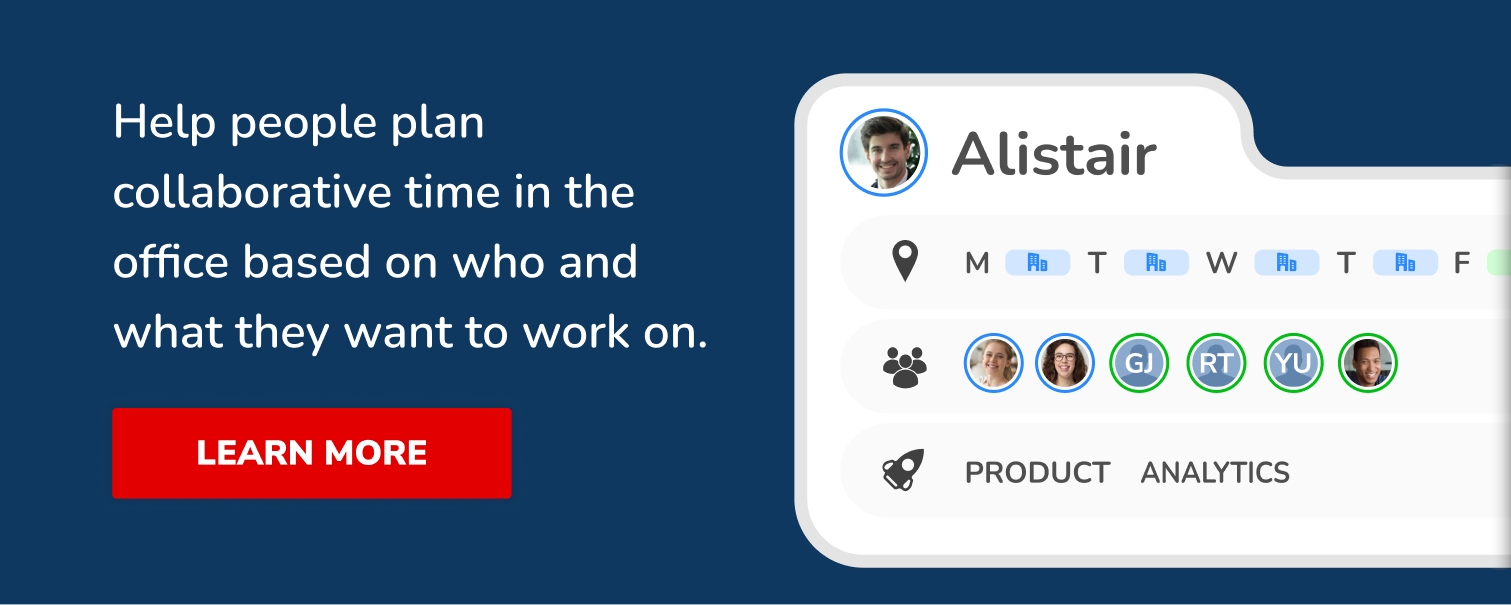As companies and their employees worldwide transition to hybrid working, the plan of who is in the office and when becomes critical. Many companies are creating hybrid team rotas to share information and organise who will be working where. Coordinating which days people attend the office and for what purpose is new for many. Employees will need support to reduce the burden of this new coordination activity and guidance on what the company expects—having a shared resource that employees can use to see who will be where and when will aid people to plan their work more effectively, making the hybrid team rota or roster essential.
As we begin to become accustomed to our new hybrid working patterns, companies will look to optimise how they work across different locations instead of almost everyone being in the same place all of the time. A focus on how employees effectively collaborate, communicate and coordinate themselves in a hybrid workstyle will be a crucial topic for companies for the foreseeable future. Helping teams adopt new ways of working to improve how they work with distributed team members is critical to the success of hybrid long term, and we think the team rota will be a crucial component.

What is a hybrid work model?
A hybrid work model is a type of flexible working that supports an individual to work part of their week from the office and part remote. In some companies, particularly when working remote, employees also have more control over their work hours.
A hybrid work model accounts for the different patterns of working that emerge across a company. The most common work patterns are three days in the office and two remote, sometimes called 3:2 (three-two) or two days in the office and three days remote, called 2:3. There are many variations of this pattern, for example, some people are required to attend their workplace each working day as their physical presence is needed to perform their role. Also, fully remote working is on the rise; positions advertised as offering full-time remote work have increased fivefold since the start of the pandemic.[1]
A hybrid work model is a way of working that supports this new reality of having many different patterns of work occurring within an organisation. As the days or times that people work in specific locations differ, the way people work needs to change so they can plan the work they need to do in person with others. As companies announce plans for specific types of work to happen in the office, like more collaborative or in-person meetings, employees need practical ways to plan their work by location. The hybrid team rota is one of the tools companies are deploying to help employees be more effective whilst working in a hybrid pattern, giving them visibility of who’s working where to enable more certain in-person collaboration.
What is a hybrid team rota?
A hybrid team rota is a way to plan, agree and share visibility of who intends to work where. Deciding to go to the office needs to be about more than if there is an available desk; it needs to prioritise the people and topics you want to work on. The hybrid team rota or roster enables teams to share information about who plans to work where.
A hybrid team rota may be self-scheduled where the employees decide when to work where or it might be centrally decided; either completely, asking employees to attend on specific days, or partially, asking them to attend for a set number of days they choose each week. Where there is choice in the rota, it is critical to produce workflow based on asking people to input their preferences and then confirming or publishing the schedule to the team.
To enable others to use the information for planning purposes, the data must be kept up to date and accurate. Nothing will devalue employees' experience of the office more than attending to work with certain people only to find things have changed and they aren’t there. Priorities, both professional and personal, change, so hybrid team rotas will not be static. Notifying people impacted by changes in a timely fashion is critical to ensure attending the office remains a valuable experience.

How do I set up a hybrid team rota?
Whether you are setting up the hybrid team rota for a single or multiple teams, you need to make sure there is buy-in to the process. Asking people to ‘just do another thing’, without clarifying the benefit or purpose is a recipe for disaster. Many people are already experiencing the inconvenience of attending office only to find key people aren’t there, schedules have changed, or that trying to coordinate being in the same place as someone is impossible when trying to find slots in busy calendars alone. Resolving this issue will motivate the workforce to enhance how they work, starting to plan their activities across the week based on when they will be co-located with key people will be worth the effort.
Set out the case that maintaining a hybrid team rota will help them plan more effective time in the office. No one wants to attend the office just because there is an available desk; it needs to be because the office is the best location to perform a specific task. As the office now competes with the cost and time of the commute for many; choosing to work there has to add value or it will be resisted.
With the teams bought in, there needs to be a set cadence of when to release the rota. It could be the week before or two weeks earlier, but it can’t be too far in advance, as the rota will change as priorities change in real-time. Certainty the information is accurate and notification of change are critical for people to place their trust in planning against the rota.
Finally, you need to provide hybrid teams with the tools to manage and use the information to help them manage their work effectively. If it's hard to do, takes unnecessary time, it will be resisted. Make the hybrid team rota simple, make it only require the minimum of effort to maintain, and keep it in a place that everyone has easy access to.

What are the types of hybrid rota
There are several ways a rota can be planned, each with its own merits. A number of these can be combined and present in an organisation or team at any one time. Here are the most frequent types seen:
Self Scheduled
Self-scheduled is the employee setting their working location. There may be guidelines or conditions placed on the decision, like working from the office a few days a week, but the employee retains some control. The ability to self-schedule gives a high level of flexibility and autonomy. It shows employers trust in them to optimise their operating rhythm and make the decisions that improve how they work themselves.
Self-scheduled comes with the challenge of balancing the whole workforce across the week and ensuring access to the days that most people want to work in the office is fair. For example, many people want to work remotely on Mondays and Fridays but having an empty office on those days is problematic. Some companies are switching to flexible workspaces where they only lease the space they need on specific days but this is not a reality for most. Also, having just a skeleton crew in on certain days may reduce the collaborative potential for some but also gives time for more focused work for those who choose to work most of the time from the office.
Manager or team-set
Manager or team set is an agreed schedule that is decided more centrally. It can be a fully fixed schedule where people are assigned days or where days are submitted and then confirmed by the manager or administrative staff. In 2020 fixed schedules were the primary method used by companies looking to get people back into the workplace. In 2021 fixed schedules are less prevalent and giving way to manager or team-set routines.
Manager or team-set rotas don't always provide for the collaboration across teams which is a key benefit of being in the office. Frequently, employees highlight easy access to team members but they miss the collaboration across different teams or networks, this is where cohort schedules come into play.
Cohort schedules
Cohort schedules for the hybrid rota allow cross-functional teams to collaborate across topics. People can belong to different groups or networks that are enhanced by in-person collaboration. Cohorts can be based on topics like projects or responsibilities and roles e.g. project managers, seniority, or any number of dimensions. Giving people the opportunity to plan office time based on the presence of a critical mass of people from these cohorts is an advanced operating style but one that maximises the use of office time.
In summary
As companies return more people to the office, providing ways for teams to plan effective days in the office will be key. The hybrid team rota provides a simple way to collate, share and confirm where people will be to aid how people plan their time by location. DuoMe offers a hybrid working scheduling tool that supports teams to create and manage their own rota. Check it out here.
1. BBC News (12th August 2021) Working from home job adverts rise







